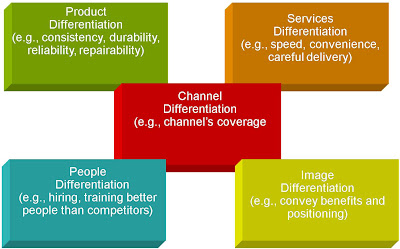General pricing approaches
Cost-based pricing
Value-based pricing
Competition-based pricing
Customer Perception of Value
Types of markets
Monopolistic competition is a market with many buyers and sellers who trade over a range of prices rather than a single market price with differentiated offers.
Oligopolistic competition is a market with few sellers because it is difficult for sellers to enter who are highly sensitive to each other’s pricing and marketing strategies.
Pure monopoly is a market with only one seller. In a regulated monopoly, the government permits a price that will yield a fair return. In a non-regulated monopoly, companies are free to set a market price.
Analyzing the Price-Demand Relationship
Factors affecting price elasticity of demand
Set a high price for a new product to “skim” revenues layer by layer from the market.
Company makes fewer, but more profitable sales.
When to use:
Product’s quality and image must support its higher price.
Costs of smaller volume cannot be so high they cancel the advantage of charging more.
Competitors should not be able to enter market easily and undercut the high price.
Market-penetration pricing
Set a low initial price in order to “penetrate” the market quickly and deeply.
Can attract a large number of buyers quickly and win a large market share.
When to use:
Market must be highly price sensitive so a low price produces more market growth.
Production and distribution costs must fall as sales volume increases.
Must keep out competition and maintain low price or effects are only temporary.
Product-line pricing
Involves setting price steps between various products in a product line based on:
Cost differences between products
Customer evaluations of different features
Competitors’ prices
Optional-product pricing
Pricing optional or accessory products sold with the main product (e.g., ice maker with the refrigerator).
Captive-product pricing
Pricing products that must be used with the main product (e.g., replacement cartridges for Gillette razors).
By-product pricing
Pricing low-value by-products to get rid of them and make the main product’s price more competitive.
Product bundle pricing
Combining several products and offering the bundle at a reduced price.
Product-adjustment pricing strategies
- Cost-based pricing
- Value-based pricing
- Competition-based pricing
- Adding a standard markup to cost
- Ignores demand and competition
- Popular pricing technique because:
- Sellers more certain about cost than demand
- Simplifies pricing
- When all sellers use, prices are similar and competition is minimized
- Some feel it is more fair to both buyers and sellers
- Uses buyers’ perceptions of value rather than seller’s costs to set price.
- Measuring perceived value can be difficult.
- Consumer attitudes toward price and quality have shifted during the last decade.
- Introduction of less expensive versions of established brands has become common.
- Going-Rate Pricing:
- Firm bases its price largely on competitors’ prices, with less attention paid to its own costs or to demand.
- Sealed-Bid Pricing:
- Firm bases its price on how it thinks competitors will price rather than on its own costs or on demand.
- May price at the same level, above, or below the competition
Customer Perception of Value
- Value-based pricing uses the buyers’ perception of value, not the seller’s cost, as the key to pricing. Price is considered before the marketing program is set.
- Value-based pricing
- is customer-driven.
- Represents the price ceiling
- Cost-based pricing
- is product-driven.
- Represents the price floor
- Good-value pricing offers the right combination of quality and good service to fair price.
- Existing brands are being redesigned to offer more quality for a given price or the same quality for less price.
- Everyday low pricing (EDLP)
- a constant everyday low price with few discounts.
- High-low pricing
- higher prices everyday but frequent promotions to lower prices temporarily on selected items.
- External factors
- The market and demand
- Types of markets
- Analyzing the price-demand relationship
- Competitors’ strategies and prices
- Other environmental factors
Types of markets
- Pure competition
- Monopolistic competition
- Oligopolistic competition
- Pure monopoly
- Before setting prices, the marketer must understand the relationship between price and demand for its products.
- The demand curve shows the number of units the market will buy in a given period at different prices.
- Normally, demand and price are inversely related.
- Higher price = lower demand
- For prestige (luxury) goods, higher price can equal higher demand when consumers perceive higher prices as higher quality.
- Price elasticity of demand illustrates the response of demand to a change in price.
- Inelastic demand occurs when demand hardly changes when there is a small change in price.
- Elastic demand occurs when demand changes greatly for a small change in price.
- Unique product
- Quality
- Prestige
- Substitute products
- Cost relative to income
- Comparison of offering in terms of customer value
- Strength of competitors
- Competition pricing strategies
- Customer price sensitivity
Set a high price for a new product to “skim” revenues layer by layer from the market.
Company makes fewer, but more profitable sales.
When to use:
Product’s quality and image must support its higher price.
Costs of smaller volume cannot be so high they cancel the advantage of charging more.
Competitors should not be able to enter market easily and undercut the high price.
Market-penetration pricing
Set a low initial price in order to “penetrate” the market quickly and deeply.
Can attract a large number of buyers quickly and win a large market share.
When to use:
Market must be highly price sensitive so a low price produces more market growth.
Production and distribution costs must fall as sales volume increases.
Must keep out competition and maintain low price or effects are only temporary.
Market-skimming VS Market-penetration
Product-line pricing
Involves setting price steps between various products in a product line based on:
Cost differences between products
Customer evaluations of different features
Competitors’ prices
Pricing optional or accessory products sold with the main product (e.g., ice maker with the refrigerator).
Pricing products that must be used with the main product (e.g., replacement cartridges for Gillette razors).
Pricing low-value by-products to get rid of them and make the main product’s price more competitive.
Combining several products and offering the bundle at a reduced price.
- Discount and Allowance pricing
- Segmented pricing
- Psychological pricing
- Promotional pricing
- Geographic pricing
- International pricing




































